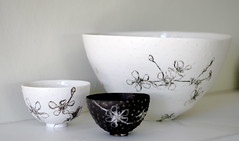
Tips for fungi hunting.........
Start in Autumn, after rain
Keep your knees bent and centre of gravity low (this is also a good tip for hip-hop dancing should you ever want to rap about fungi with the guys in da 'hood)

Get your "fungi eyes" on. Once you start seeing them you'll see them everywhere.

Look around the roots of trees, on rotting stumps and under ferns..fungi pop up in the strangest places.

Expect weird and unusual shapes and beautiful colours.


These fungi are all from Stradbroke Island and the process of fungi hunting became totally addictive, the variety of these wonderful organisms is fascinating. The fungi we see aboveground is often only 10% of the entire organism. Fungi have no chlorophyll and feed by producing enzymes underground that break down complex molecules found in organic matter. As they exhaust the food supply the underground mycelium move further out.

The actual fungi is the fruiting body of the organism known as the
sporocarp, it's purpose is to disperse the microscopic spores which get carried by the wind far and wide to produce a new web of mycelium that will erupt with a sporocarp when the conditions are right. There are so many interesting fungi facts for instance
:"All fungi need existing organic matter for their food. A fungus that feeds on dead organic matter is called a saprotroph and one that feeds on living organisms is a parasite. While there are species that are always parasitic and others that are always saprotrophic there are also those which may feed on either live or dead organic matter and so change from parasitic to saprotrophic behaviour (or vice versa), depending on what food sources are available. " Read more about fungi
here.

 I have some early swamp cartography pieces in a Redlands group jewellery/metal show coming up soon and also a piece selected for the Waterhouse Natural History Art prize in South Australia.
I have some early swamp cartography pieces in a Redlands group jewellery/metal show coming up soon and also a piece selected for the Waterhouse Natural History Art prize in South Australia.












